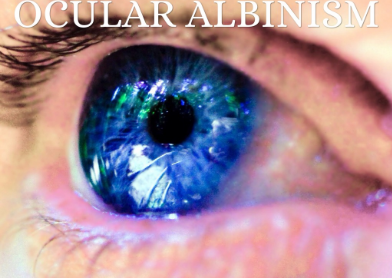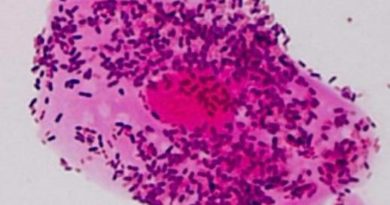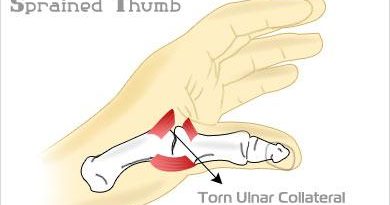Ocular Albinism
What is Ocular Albinism?
From the term ‘albinism’, which is a group of genetic disorders characterized by partial or total lack of melanin in the eyes, skin or hair, ocular albinism affects the eyes. It is however, a rare disease that has various types in which it can manifest.
The most common form is observed in males known as ocular albinism type 1 (OA1). This changes the way their eyes look or behave causing them to have difficulties with their vision. Patients may, therefore, require special glasses or contact lenses.
Children, who suffer from vision limitations caused by ocular albinism at birth are observed to get better as they grow older. In addition, people suffering from this type of albinism have normal skin and hair pigmentation.
Other names that refer to ocular albinism are:
- Nettleship-falls ocular albinism
- X-linked ocular albinism
- XLOA

Fig: African blue-eyed boy with ocular albinism
Ocular & Oculocutaneous Albinism
Albinism can be divided in two categories: oculocutaneous and ocular albinism. Oculocutaneous presents as abnormal pigmentation in both the skin and eyes but ocular albinism mainly affects the eyes with little or no effect on the skin.
People with oculocutaneous albinism have a mutation in one of four genes giving the types OCA type 1, OCA type 2, OCA type 3, and OCA type 4 that present differently in both the skin and eyes of affected individuals.
On the other hand, the common X-linked ocular albinism is a gene mutation on the X-chromosome almost exclusive to males. People with ocular albinism have vision problems but their skin and eye color is within the normal range.
Causes
Genetics
Albinism is a gene mutation in one of several genes significant in the synthesis of proteins that produce melanin. The mutation may result in there been no melanin or a reduction in its production. Melanin is produced by cells found in your skin and eyes.
When the mutations are on the X-chromosome in the GPR143 gene responsible for encoding a protein expressed in the retinal pigment of the eye, ocular albinism type 1 is observed. In rare cases, the genetic cause of this condition is unknown.
The GPR143 gene is also involved in the regulation of the melanin pigment formation. Furthermore, the mutations result in enlarged abnormal premelanosomes, which are the intracellular locations where melanin is produced in the pigment cells (melanocytes). Though these abnormalities of the melanosomes are also present in the skin, they do not seem to reduce the amount of skin and hair pigmentation.
Therefore, the affected individuals generally have normal skin color. However, the gene GPR143 is involved in the intracellular signaling of the retina and hence mutations will affect their vision.

Hereditary
In most cases, ocular albinism is inherited as an X-linked recessive genetic condition. X-linked genetic disorders are as a result of an abnormal gene on the X-chromosome in carrier females and affected males. The females are carriers because they have the disease on one of their two X chromosomes and, therefore, two copies of the GPR143 gene. When one is affected, the other compensates. Also, usually half of the cells in their eyes will have the normal X chromosome activated resulting in normal vision.
The males only have one X chromosome and, therefore, one copy of the GPR143 gene. They develop the disease if they inherit the chromosome with the diseased gene from their mothers.
If affected, women may only have mild changes in retinal pigmentation that may be detected during an eye examination. When they have more significant signs and symptoms of ocular albinism type 1, it may be due to one of the following
- A phenomenon called skewed X-chromosome inactivation
- Inheriting two mutated copies of the GPR143 gene
- Having partial deletion of the X chromosome.
Males with the X-linked gene disorder also pass it to all of their daughters but not to their sons. This is because men only pass the Y chromosome to their sons. On the other hand, females with the same disorder have a 25% chance to pass it to either their sons or daughters respectively.
Prevalence
One male in 20,000 births is reported to have the condition.
Signs & Symptoms
Ocular albinism affects the pigment formation in the eyes and presents with vision problems including:
Nystagmus
- Which is the involuntary movement of the eyes back and forth. According to statistics provided by HPO, this occurs in 80%-99% of the cases. Congenital motor nystagmus is a genetic condition has been seen in several different Chinese families. Affected males do not have additional changes typical in individuals with X-linked ocular albinism, for example, reduction in retinal pigmentation. Female carriers are however, unaffected.
Foveal hypoplasia
Where the fovea fails to develop resulting in blurred vision is also recorded to be in 30%-79% of the cases.
Others
- Hypopigmentation- presented as reduced iris and retinal pigmentation.
- Strabismus- which is observed as crossed eyes is also common with similar prevalence as foveal hypoplasia.
- Sensitivity to light and photophobia are also common in 80%-99% of the affected individuals.
- Abnormal connections occurring in the nerves that run from the retina to the brain preventing the eyes from tracking together.
- Abnormality of the pupil in 80%-99% of the cases.
- Astigmatism- presenting as irregularly shaped cornea which is the curvature in the front surface of the eye. It is also in 80%-99% of patients with ocular albinism.
- Giant melanosomes in melanocytes is occasional with only 5%-29% of the cases
- Myopia is also occasional with the same prevalence of 5
Diagnosis
A genetic or rare disease is often challenging to diagnose. Health care professionals normally look at a person’s medical history, symptoms, physical exam, and tests to make such diagnoses.
With ocular albinism, diagnosis is based on the characteristic eye findings that include retinal pigment abnormalities. Molecular genetic testing to detect mutations of the GPR143 gene is able to confirm the diagnosis.
Treatment
Generally, the diagnosis of albinism in man is based primarily on the ocular findings. When diagnosed, patients should be evaluated by an ophthalmologist to determine the extent of the disease. Treatments to manage the condition are given as follows:
- Hyposensitivity to light is the most incapacitating symptom that can be relieved by using sunglasses.
- Refractive errors should be treated as early as possible with appropriate spectacle correction. Where abnormal head posture develops from conditions likenystagmus, prismatic spectacles can be used to correct it.
- Strabismus surgery is usually performed for cosmetic purposes especially when the face turn is marked or fixed.
To control the effects of long exposure to the sun, using sun-protective clothing and lotions may also help. In addition, children should have annual ophthalmologic exams while adults can do with two to three years of the same.
Reference List
- Ocular albinism. http://www.webmd.com/eye-health/what-is-ocular-albinism#1
- Rare diseases. https://rarediseases.org/rare-diseases/ocular-albinism/
- Ocular albinism.http://www.medicinenet.com/script/main/art.asp?articlekey=2185
- Albinism. http://www.mayoclinic.org/diseases- conditions/albinism/basics/causes/con-20029935
- http://emedicine.medscape.com/article/1216066-overview
- http://www.news-medical.net/health/Albinism-Partial-Absence-of-Pigment-in-the-Skin.aspx


